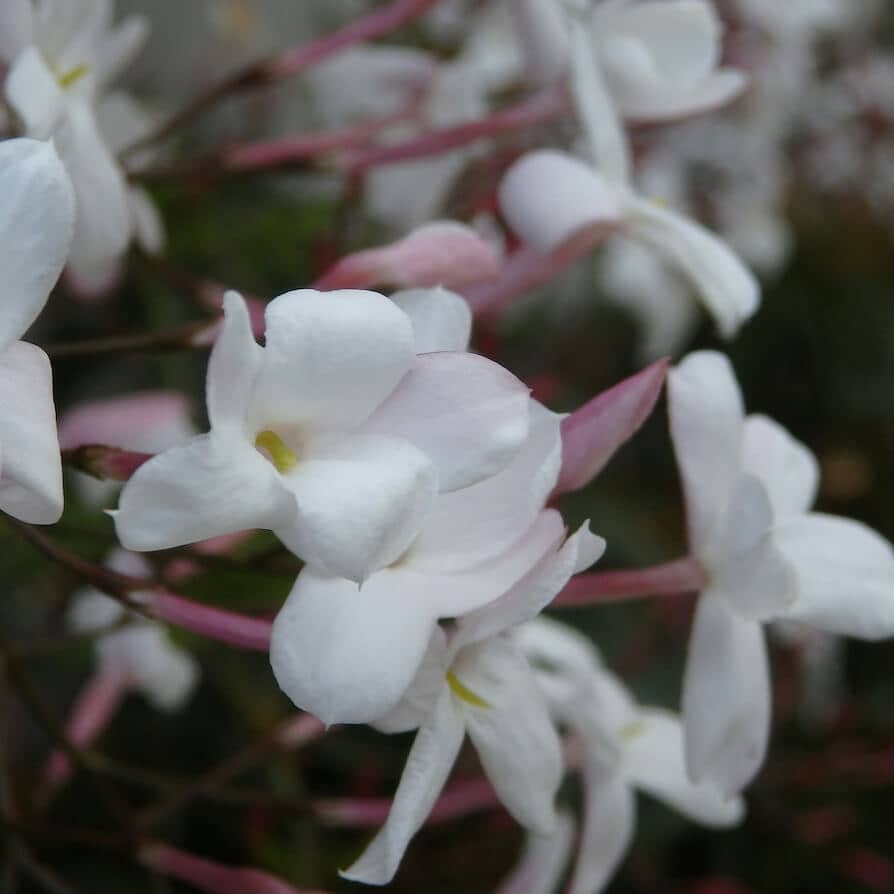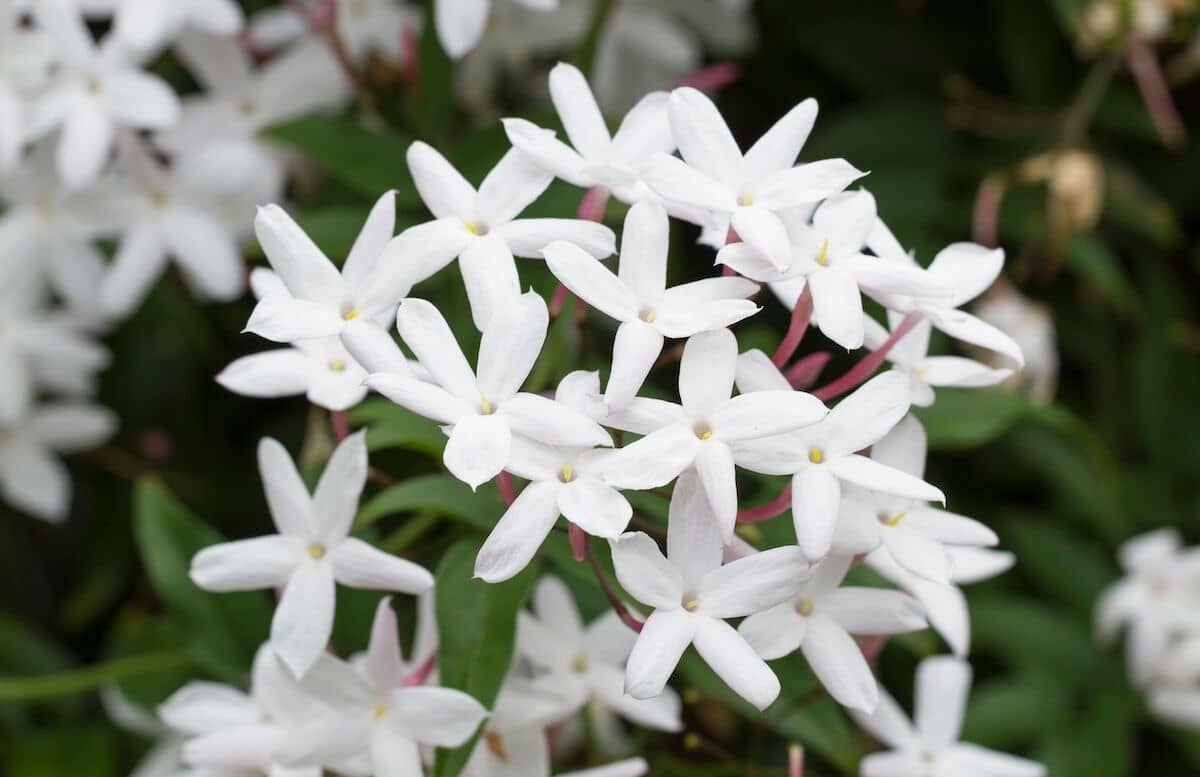
Position
- Full sun or partial shade
- Sheltered south or west-facing position
- Protected from cold winds
- Warm wall ideal
Hardiness
- Tolerates temperatures down to -10°C (14°F)
- Fully hardy throughout UK
Soil
- Well-drained, moisture-retentive soil
- Fertile loam preferred
- Can tolerate most soils if well-drained
- Adaptable to neutral or alkaline soils
- Performs best in neutral
- Grab a soil test kit and ensure the perfect conditions for growth
Height
- Height: 6-8 metres
- Spread: 2-3 metres
Seasons of Interest
- Flowering: June to September
- Highly fragrant white flowers
- Dark green foliage from spring to autumn
- No significant autumn colour
- No variegation
- Semi-evergreen in mild winters
Additional Notes
- Intensely fragrant, especially in evening
- Often grown near windows or seating areas for scent
- Can be grown in large containers
- Regular pruning needed to maintain shape
- May need protection in severe winters
- Best flowering on current year’s growth
- Good for pollinators, especially moths
- Takes 2-3 years to establish properly
- May need tying in regularly during growing season
- Benefits from annual mulching in spring
Growing Jasminum officinale: How to Cultivate the Timeless Scent of Common Jasmine
Jasminum officinale, commonly known as common jasmine, is a cherished deciduous climber renowned for its heady fragrance and elegant, star-shaped white flowers. Flowering profusely throughout the summer brings timeless romance and sensory pleasure to garden walls, fences, pergolas, and arbours. In this in-depth growing guide, you’ll learn how to plant, support, and care for common jasmine to ensure vigorous growth and abundant blooms.
What is Jasminum officinale?
Jasminum officinale is a vigorous, twining climber in the olive family (Oleaceae). It’s native to parts of Asia but has long been cultivated in UK gardens for its captivating scent and graceful appearance. Flowering from June through August, the plant produces dense clusters of pure white, star-like flowers that release their strongest perfume in the evening, making it a favourite near patios and outdoor seating areas.
The deciduous foliage comprises small, dark green pinnate leaves, which provide a soft, attractive backdrop to the bright blooms. When well supported, this climber can reach heights of 6–9 metres (20–30 feet), making it ideal for vertical gardening or softening complex architectural features.
Where is the Best Place to Plant Common Jasmine?
To get the most from Jasminum officinale, choose a position in full sun that can soak up warmth throughout the day. Although it can tolerate partial shade, flowering is far more generous when plants receive at least 6 hours of direct sunlight. A sheltered south or west-facing wall is ideal, especially one protected from cold, drying winds.
Soil should be fertile, moisture-retentive, and well-drained. Before planting, plenty of well-rotted organic matter—such as well-rotted manure or leaf mould—must be worked into the soil to improve structure and feed the roots. Avoid waterlogged areas, as jasmine dislikes wet feet in winter.
How to Support Jasminum officinale
As a natural twiner, common jasmine needs support to climb effectively. Before planting, install a strong trellis, tensioned wires, or an obelisk to provide a stable structure for the plant to latch onto. Attach supports securely to walls or fences, allowing space behind for airflow and maintenance access.
As the stems grow, gently tie them into the support using soft garden ties, spacing them evenly to encourage balanced coverage. Left unsupported, jasmine can become tangled and unruly, so regular training is essential to maintain a neat appearance and maximise flowering surface.

Flowering Time: When Does Common Jasmine Bloom?
Expect your Jasminum officinale to flower from early summer into late August, with some specimens continuing into early autumn if conditions are favourable. The white flowers emerge in clusters at the tips of new growth and are followed by small, ornamental black berries later in the season.
The scent is most potent during warm, still evenings — a lovely addition near windows, garden seating areas, or doorways where it can be fully appreciated. Regular watering and a sunny position will help ensure consistent blooming throughout the season.
How to Care for Jasminum officinale Throughout the Year
Once established, this climber is easy to maintain, but it benefits from annual pruning and seasonal care to remain healthy and productive.
- Watering: Water newly planted jasmine regularly in the first year. Once established, it becomes more drought-tolerant but still appreciates a soak during prolonged dry spells.
- Mulching: In spring, apply a generous layer of mulch around the base. This helps conserve moisture, enrich the soil, and suppress weeds.
- Feeding: Feed in spring with a balanced, slow-release fertiliser to promote strong growth and flowering. A high-potash liquid feed can also be applied monthly during the flowering period.
- Pruning: Prune immediately after flowering by removing up to one-third of the old flowered stems. Cut back any tangled, straggly or dead growth to maintain shape and encourage fresh shoots.
Is Common Jasmine Suitable for Small Gardens?
Absolutely. Despite its vigorous habit, Jasminum officinale can be trained vertically in compact gardens without overwhelming the space. With regular pruning and support, it’s perfect for greening up a small courtyard wall, screening a bin area, or softening the edge of a shed or garage.
Because it grows up rather than out, it’s an excellent choice where horizontal space is limited but vertical space is available. The fragrant blooms also make it a natural companion for entertaining areas or secluded corners of the garden.
Popular Varieties of Jasminum officinale
While the classic species is widely available and highly reliable, several cultivars offer distinct features to suit different garden styles:
- ‘Inverleith’ – A more compact selection for smaller spaces or container growth.
- ‘Argenteovariegatum’ – Noted for its creamy white and green variegated leaves, which provide year-round interest even when not in flower.
- ‘Aureum’ – Grown for its golden yellow foliage, adding brightness to darker corners or mixed planting schemes.
- ‘Affine’ – Features larger, more fragrant flowers than the species.
- ‘Clotted Cream’ – Offers rich, creamy-coloured blooms with a strong fragrance, adding a slightly warmer tone to traditional white jasmine flowers.
Each variety shares the same fundamental care needs but offers variation in foliage or flower size to help personalise your planting scheme. Whether you’re looking for subtle leaf variegation, compact form, or a twist on the classic flower colour, there’s a jasmine cultivar to suit your garden’s character.
How Quickly Does Jasminum officinale Grow?
When provided with the right conditions — sunlight, support, and good soil — Jasminum officinale establishes rapidly. Growth in the first year focuses on root development, but by year two, you’ll see significant extension of climbing stems. Mature plants can grow several feet each season, easily cloaking structures or spreading across a pergola.
This fast growth makes it a brilliant choice for covering unsightly fences or quickly creating privacy, but it also means regular attention is needed to prevent it from growing out of control.
Winter Care Tips for Common Jasmine
Although hardy in most parts of the UK, young jasmine plants can benefit from extra protection during their first winter. In late autumn, apply a mulch of bark or compost around the root zone to insulate the base and retain soil warmth.
Consider using fleece or hessian to shield young stems from harsh winter gales in exposed or windy gardens. Once established, Jasminum officinale is robust and reliably returns each spring with new shoots and fresh foliage.
From Darren’s Patch
There’s something undeniably special about brushing past a jasmine in full bloom on a summer evening — the scent stops you in your tracks. I’ve got Jasminum officinale growing along a west-facing fence near the seating area, and it’s become one of those plants I genuinely look forward to every year. It’s not fussy; it just wants sunshine, support, and a bit of pruning after flowering — and in return, it puts on a fantastic show. I particularly enjoy the ‘Clotted Cream’ variety for its creamy tone; it feels slightly more refined than the pure white types if you’re after a climber delivering beauty and fragrance without being overly demanding. Common jasmine is a garden classic that pulls its weight.
![]()
Key Points to Remember:
- Provide a strong support structure
- Flowers from June to August
- Sweetly scented white flowers
- Needs well-drained soil
- Regular pruning maintains shape
- Suitable for walls and fences
- Loses leaves in winter
- Various cultivars available
- Vigorous vertical growth
Jasminum officinale remains a cherished choice for gardeners who value scent, elegance, and reliable summer flowering. Its sweetly perfumed, star-shaped blooms bring classic charm to any outdoor setting, whether adorning a trellis, cloaking a sun-drenched wall, or weaving through an archway in a cottage garden.
With structural support, regular pruning, and a well-chosen sunny spot, common jasmine rewards you season after season of beautiful growth and intoxicating fragrance. And with a growing selection of cultivars like ‘Argenteovariegatum’, ‘Affine’, and the buttery-hued ‘Clotted Cream’, there’s plenty of scope to personalise your planting scheme.
Whether you’re creating a romantic seating area, a vertical privacy screen, or simply looking to add fragrance to a small space, Jasminum officinale offers beauty and performance in equal measure. It’s a climbing classic that earns its place in any well-planned garden.
Check out the RHS article here.
Explore our full collection of planting guides for expert advice on climbers and wall shrubs.
Want to learn about other climbers? Read about Lonicera Celestial here.
Frequently Asked Questions
Q: How do I prune my Jasminum plants?
A: Pruning is essential to maintain the shape and health of your shrubs and climbers. It’s best to prune away dead or damaged stems in late winter or early spring before new growth starts. Just be gentle, as these plants can be a bit sensitive.
Q: What are the ideal conditions for planting Jasminum?
A: These beauties thrive in well-drained soil and prefer partial shade and colder positions. They’re great for covering a large south-facing wall or trellis, so pick your spot wisely!
Q: Where can I buy jasmine for my garden?
A: You can buy jasmine from online retailers or local garden centres.
Q: What type of soil do Jasminum plants prefer?
A: They require free-draining soil to thrive. If your garden has heavy clay soil, consider amending it or planting it in raised beds to ensure it gets the necessary drainage.
Q: Can I grow Jasminum in pots?
A: Absolutely! Jasminum plants can do well in pots, especially if you choose a 3-litre pot and ensure proper drainage. Just remember to water them regularly and give them enough sunlight!
